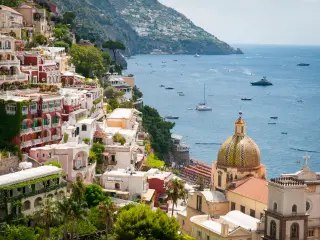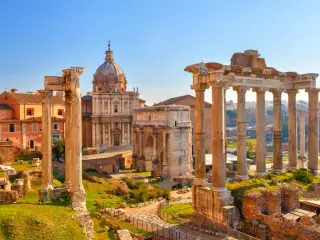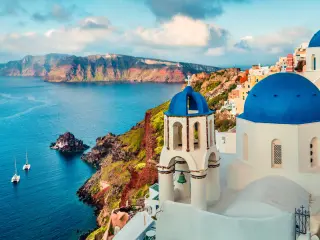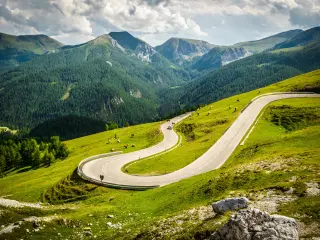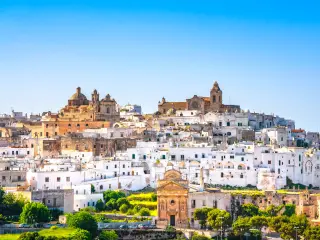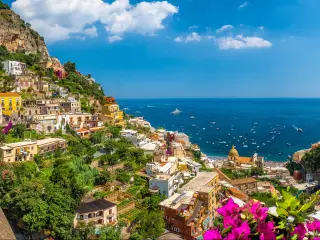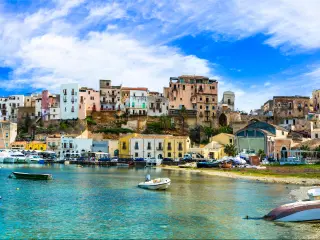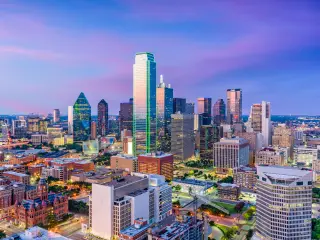Driving in Italy: Toll roads, driving rules, parking and top tips
Don't be intimidated by the idea of driving in Italy; our driving guide will provide you with all the tips and tricks you'll need to be completely prepared - from how to navigate roundabouts and what to keep in your car to how to decipher those cryptic Italian road signs.
Etiquette
It may be a stereotype, but it's true that Italian drivers are typically speedier and more aggressive than those in the UK, with lane-hopping and tailgating common practice. Be wary on the roads - especially if you're navigating bendy routes like the Amalfi Coast.
What do flashing lights mean?
In the US and the UK, a driver will flash their lights at you to indicate that they see you, or that they're allowing you to cut in front. In Italy, however, flashing means the complete opposite, something akin to "get out of the way" or "don't pull out now because I'm not stopping."
If someone flashes at you when they're approaching, it means there's a police check up ahead.
What about honking?
In Italy, honking can mean anything from "Watch out" to "Buongiorno!" to "Italy has just won an important sports match; let's celebrate." Alternatively it can mean something along the lines of "Hurry up, the light has just turned green and I'm in a rush!"
If you're driving along winding mountain roads, some people honk to warn approaching traffic that they're coming around the bend.
And note that when driving through small towns and villages, you should only use your horn in the event of an emergency.
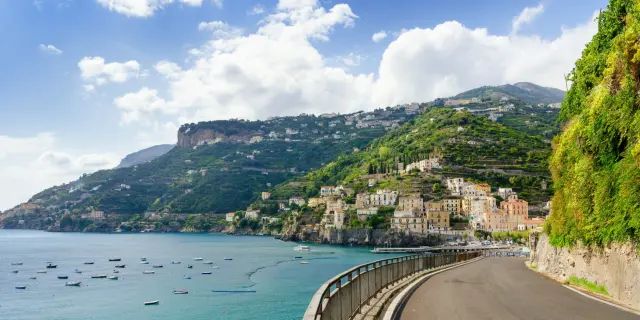
Rules of the road
- Which side do they drive on? Just like most of continental Europe, Italians drive on the right side of the road.
- Age limit: You must be over the age of 18 to drive in Italy, and 21 to rent a car.
- No right on red: US travellers - note that right turns on red lights are always illegal.
- Mobile phones: Mobile phone use is not allowed while driving, but you can use hands-free and bluetooth devices.
- ZTL Zones: Many historic Italian cities have a ZTL zone (zona a traffico limitato - reduced traffic zone) in the city centre, designed to reduce congestion and pollution. If you're caught driving in a ZTL, a hefty fine will be issued immediately and sent to the home address associated with the credit card you used to rent your car. So it helps to know what to look out for. ZTLs are indicated by a white sign with a red circle on it. Below the circle are the hours in which you are not allowed to enter the zone.
- Blood alcohol limit: Drink-driving laws are strict in Italy; the blood alcohol limit is 0.05% - which means you cannot drink more than one glass of wine before hitting the road. If you have less than three years' driving experience, the limit is 0%.
- Slow and fast lanes: On three-lane motorways, the lane on the right is reserved for slow vehicles and vehicles that are not overtaking. The left lane is truly only used for passing - so stay out of there if you're just cruising along at a normal pace.
Headlights: When you're driving in tunnels and on motorways, dual carriageways and out of town roads during the day time, you must use dipped headlights.
Roundabouts
Italian roundabouts (called rotundas or rotarias here) can appear intimidating and confusing at first, as they tend to have up to five or six exits. But in fact you navigate them much the same as you would in the UK.
Drivers entering the roundabout have to give way to those who are already on it, and you should always use your blinker when you're exiting.
Note that even if it's a one-lane roundabout, drivers in Italy have a knack for turning it into two lanes.
Bear that in mind, drive carefully, and use your indicators, and you should be just fine.
What do I need in my car?
Documents
- If you have a US license (or a license from anywhere outside EU) you should carry an international driving permit along with your local license
- If you're from the UK, bring along a full and valid UK driver's license
- Proof of at least third-party insurance
- Proof of insurance and car ownership
- Passport or national ID card
- Car documents and insurance papers
Items
- Reflective safety vest
- Warning triangles
- It's obligatory to display a GB sticker if you're driving a UK car without a GB-euro symbol number plate
- Headlamp beam deflectors
- BANNED: speed camera detectors
What should I probably have in my car?
- Some change for parking metres
- A GPS system (or Google maps offline)
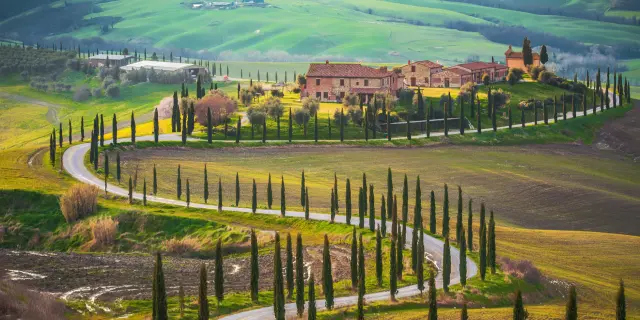
Speed limits
The speed limits in Italy are usually indicated in kilometres per hour in white and red circle.
- In normal weather conditions, the motorway national speed limit is 130km/h (80mph).
- In wet conditions, the motorway limit is 110km/h (70mph)
- Outside built up areas, the national speed limit is 90 km/h
- In big cities, the limit is 50km/h
- On curvy sections of the road, the speed limit can be as low as 60km/hour, so keep an eye out for those signs.
Tolls on Italian roads
Italian toll roads are called Autostrada, and each one charges a specific fee depending on the distance driven. (For example, the 215km drive from Milan to Bologna will set you back €14.60)
You must take a ticket when you enter the autostrada, and pay the fee when you exit. Make sure you take a ticket before entering, or else face a heavy fine! Some toll booths don't accept certain types of card, so be sure to have cash on you just in case.
When you exit the Autostrada, do not drive into the Telepass lane; this lane is reserved for locals who are charged electronically on a monthly basis for tolls.
Insurance
In order to drive in Italy, it's required to be covered by third-party liability insurance. This protects you in the event of material damage to another vehicle, or in the case of a road accident resulting in the injury or death of someone else.
Parking
Parking (or Parcheggio, as it's called in Italian) is notoriously difficult in Italy. Here's what you need to know:
Blue lines
Blue lines can mean two things in Italy:
Pay-and-display parking, in which you pay at a metre and display the ticket on your dashboard. Generally the machines accept both coins and cards, and usually these spots become free between 8pm and 8am.
Free parking with a blue "disco" (disc). You can buy a blue disc from banks, tobacconists, tourist offices and post offices, and this allows you to park for free in a paid blue parking zone. You must display the disc on your dashboard, with the clock set to the exact time you parked.
White lines
White lines indicate free parking spaces. These are few and far-between, especially in big cities, and they sometimes come with time restrictions, so keep an eye out for signs.
On-street parking is also permitted on the right side of the road, free of charge.
Yellow lines
Parking areas marked with yellow lines are "special zones" reserved for handicapped parking and deliveries.
Green lines
In green zones parking is not permitted on weekdays between 8am and 9:30am and between 2:30pm and 4pm
Pink lines
Again these are rare, but spots marked with pink lines are reserved for expectant mothers and women with infants.
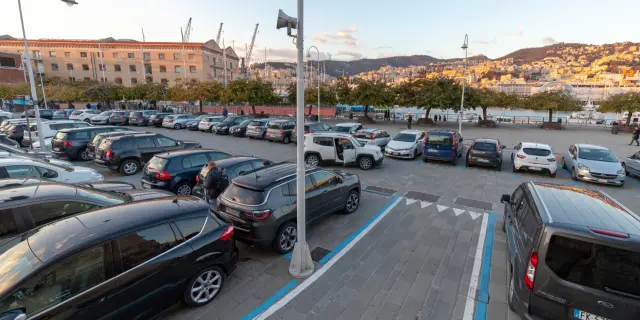
Fuel
Good to know:
- On Autostrada, petrol stations are self-service and open 24 hours a day.
- Smaller petrol stations tend to close on Sunday afternoons and during lunchtime (around 1pm to 3pm ) on weekdays.
- Expect to pay slightly more for petrol in Italy than you would in the UK.
Important phrases to know
- destra (right)
- sinistra (left)
- dritto (straight)
- uscita (exit)
- pedaggio (toll)
- benzina (petrol)
- gasolio (diesel)
- Uscita(exit)
- Entrata (entrance)
Emergency phone numbers
- Emergency road service: Dial 116
- Police: Dial 113 or 112
- Fire department: Dial 115
- Ambulance: Dial 118.
Special emergency telephones are situated every 2km on the Autostrade and other major highways.
There are two types of telephone you'll see: one where you can speak to the emergency centre, and one where you must press a button with a spanner on it for mechanical assistance or a button with a cross on it for medical aid.
A red light lets you know that the message has been received at the central motorway alarm system and help is on its way.


